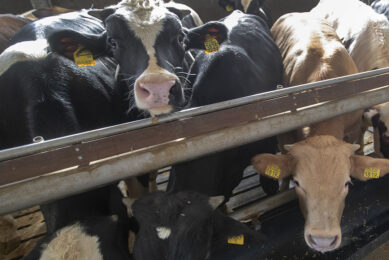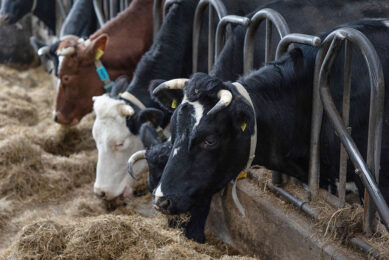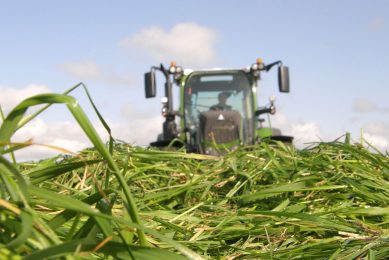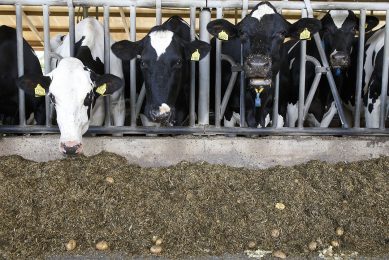From nutrition to laminitis – acidosis is the missing link
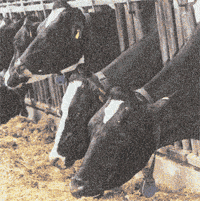
The critical link between nutrition, acidosis and laminitis appears to be associated with altered haemodynamics of the peripheral microvasculature. In many dairy operations, the challenge is not with acute, but sub-clinical acidosis. Daily ruminal pH below certain thresholds (5.0) for given periods of time predisposes cattle to low grade, subclinical acidosis with symptoms including erratic appetite, loss of body weight, diarrhoea and lameness.
James E. Nocek
The scientific name for laminitis is "pododermatitis aseptic diffusa". Translated it means an aseptic inflammation of the dermal layers inside the foot. Table 1 illustrates the types and percentages of foot lesions found in the largest survey of laminitis recorded (Russell et al., 1982). Of the total spectrum of lesions identified, approximately 62% of them could be associated with laminitis in some form, suggesting its importance as a cause of lameness.
Laminitis is often referred to as a syndrome. It has a multi-factorial aetiology, and it is thought to be associated with a spectrum of largely interdependent factors. Although nutritional management influences the development of laminitis, metabolic and digestive disorders can also predispose animals to it. Hormonal changes associated with parturition and other phases of the animal’s lactation cycle can have an impact on certain physiological changes. Infectious diseases such as mastitis, metritis and foot rot can impose specific endotoxic insults (Maclean, 1971). Environmental aspects such as hard stall surfaces, lack of bedding, or little use of bedding, lack of exercise, or excessive exercise on undesirable surfaces can predispose animals to mechanical damage (Bergsten, 1994). Other factors such as body condition, body weight, and feet and leg structure can unnaturally increase the weight load and stress on feet exacerbating internal mechanical damage.
Acidosis as a cause of laminitis
Since intake was restricted on the 60:40 diet and grain fed in a TMR, the major difference between dietary treatments was concentrate intake (9.1 versus 5.8 kg concentrate or 5.7 and 1.7 kg of barley). Cows fed high concentrate produced 1.2 kg more milk, 0.15 percentage units more protein and produced 0.16 kg more milk/kg DM than cows fed low concentrate. This study, therefore, demonstrates the effect of carbohydrate level and availability on lameness, but also shows that increased non-structural carbohydrate (NSC) levels enhance production performance.
Other researchers (Livesey and Fleming, 1984; Manson and Leaver, 1988; Mortensen, 1994) have shown a relationship between feeding high carbohydrate diets, feeding frequency and severity of digital lesions.
We can control the incidence of laminitis through nutrition by feeding high fibre diets, and using good feeding and management practices. However, most dairy producers are in the business to make a profit. Increasing concentrate intake to a certain threshold maximises milk production and milk components. In doing so, dairy managers walk the fine line between maximising profit and dealing with sick and lame animals.
The carbohydrate source
The way feeds are given can have a significant impact on the stability of ruminal pH. As the amount of concentrate goes up in the diet and/or the diet increases in fermentable carbohydrates, saliva production and time of rumination decreases which decreases ruminal pH. Kaufmann et al. (1980) showed that feeding frequency of concentrates has a significant impact on containing a stable ruminal pH. Nocek (1992) identified that feeding the same ingredients and forages in different strategic fashions during the day can influence the time ruminal pH remains below a given threshold.
The influence of carbohydrate on rumen pH is the critical link between nutrition, acidosis and laminitis. Although excessive levels of ruminally available carbohydrate are blamed for increased acid production and overwhelming the bicarbonate buffering systems, lack of effective fibre can significantly influence saliva production and ruminal pH. Effective fibre stimulates chewing, which in turn stimulates saliva secretion. Buffers in saliva neutralise acids produced by ruminal fermentation. Therefore, ruminal pH is a balance between acid production from carbohydrate substrates and saliva production (buffering action). Substantially more information is needed to quantify physically effective (pe) NDF. Just because a certain proportion of particles is greater than 2.54 cm, does not render it effective. It may be digested or contribute to acid production, especially improperly fermented, wet forages with high NSC and lactic acid levels.
The relationship between ration NSC, rumen available starch, NDF, and eNDF is critical in maintaining proper rumen function. Poore et al. (1993) fed diets similar in NDF (30%) in a factorial study where sorghum was either dry rolled or steam flaked and wheat straw was substituted for alfalfa hay. Chopped wheat straw substituted for alfalfa hay did not affect milk yield or composition. Increasing starch degradability increased milk yield and protein regardless of fibre source. These researchers suggest that a ratio of forage NDF to ruminally degradable starch should be maintained (about 1:1) to avoid depression in fibre digestion and maintain normal rumen function. Nocek and Russell (1988) showed milk yield to be maximised when the NSC to NDF ratio was between 0.9 and 1.2.
The addition of hay to diets does less to enhance the effective fibre of the diet than increasing the particle size of silage. Although small amounts of hay added to the diet increase intake compared to increasing silage particle length, it did not appear to affect milk production or composition in diets considered low in effective fibre (Beauchemin et al., 1984). No reference was made to rumen pH thresholds in these studies.
Factors such as the amount and type of grain, grain processing, forage type, quality, levels, etc. influence intake patterns, energy metabolism, and sub-clinical acidosis. Rate and extent of digestion and amount of starch intake modifies the severity of acidosis. Grain mixes containing finely ground or highly processed cereal grains (i.e., corn, wheat, barley) have the fastest rates of ruminal starch digestion (Nocek and Tamminga, 1991). It is critical that the grain portion of the diet complements the forage type and quality and contains ingredients with various levels of rumen carbohydrate availability. Both low roughage levels and reduced particle size exacerbate acidosis during the transition period.
Protein in the ration
Although not covered extensively in this review, the amount of ration protein has been shown to influence the incidence of laminitis. Manson and Leaver (1988) compared feeding a 16.1 versus 19.8% crude protein diet. The high protein diet significantly increased locomotion scores, number, and duration of clinical lamenesses for dairy cattle between 3 and 26 wk postpartum. Bargari et al. (1992) studied the influence of feeding 15.3 versus 18% crude protein on farms with "normal" calves and those affected with laminitis. Blood urea nitrogen levels on affected farms were elevated in both normal and affected calves in affected herds. Total protein globulin and packed cell volume were elevated in affected animals on affected farms. Therefore, high levels of rumen degradable protein have been identified as a factor of increased lameness and laminitis. There is little information available to identify what role protein may play in the development of lameness. Several postulations involve allergic histaminotic reactions to certain types of proteins (Nilsson, 1963) or a link between high protein supplementation and protein degradation end-products.




